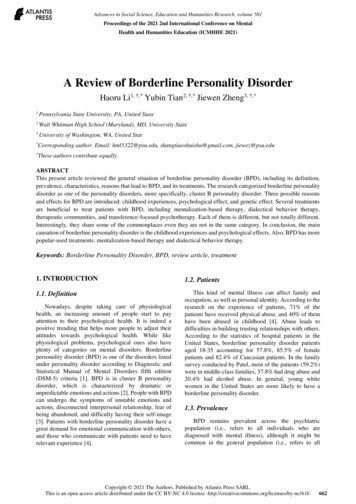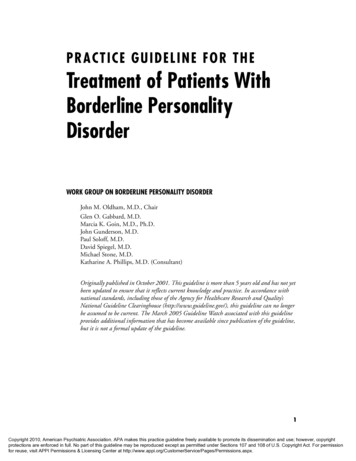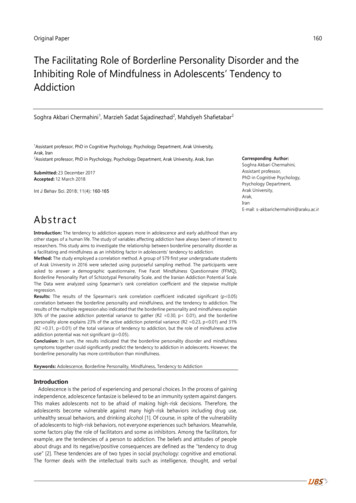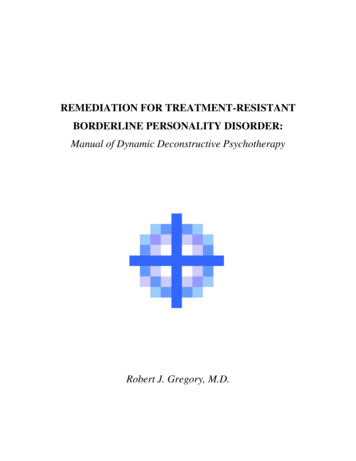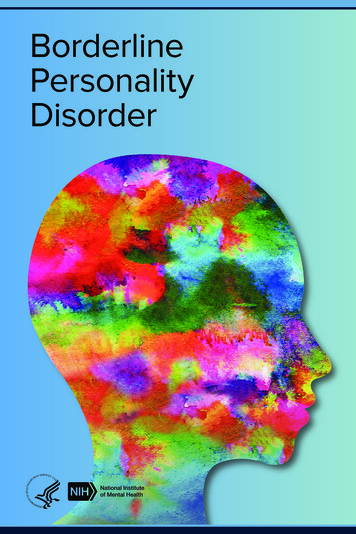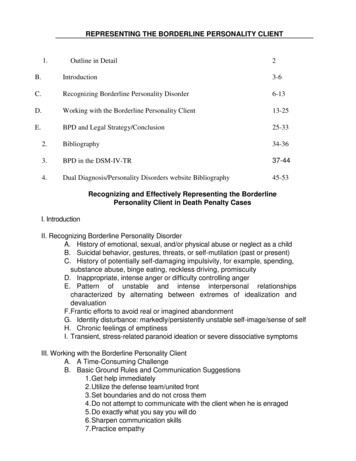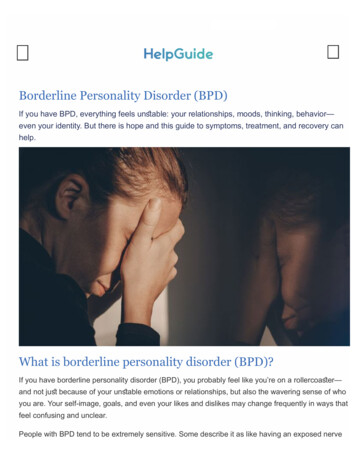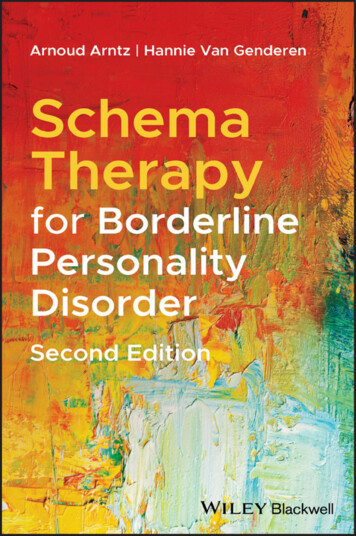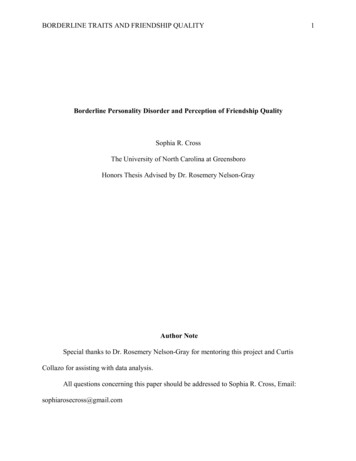
Transcription
BORDERLINE TRAITS AND FRIENDSHIP QUALITYBorderline Personality Disorder and Perception of Friendship QualitySophia R. CrossThe University of North Carolina at GreensboroHonors Thesis Advised by Dr. Rosemery Nelson-GrayAuthor NoteSpecial thanks to Dr. Rosemery Nelson-Gray for mentoring this project and CurtisCollazo for assisting with data analysis.All questions concerning this paper should be addressed to Sophia R. Cross, Email:sophiarosecross@gmail.com1
BORDERLINE TRAITS AND FRIENDSHIP QUALITY2AbstractPerceived friendship quality is an important aspect of physical and mental health (Nicholson,2012; Pucker et al., 2019). Prior research on Borderline Personality Disorder (BPD) hasexamined romantic partner relationships, social network quantity, and social networkfunctioning. No research has examined perception of friendship quality in individuals withelevated BPD traits. Given overall interpersonal relationship dysfunction in BPD, it is importantto understand all relationship domains to fully conceptualize this dysfunction. This study aimedto fill that gap in research by examining perception of friendship quality in a male and femalecollege sample of 265 participants with differing levels of BPD traits; these traits were measuredusing the Wisconsin Personality Disorder Inventory-Borderline Features (WISPI-BOR; Klein etal., 1993). Participants filled out self-report measures administered online. The study used afactor conceptualization of perceived friendship quality, the McGill Friendship Questionnaire(Mendelson & Aboud, 1999). Each of the functions of friendship was examined individually(Stimulating Companionship, Help, Intimacy, Reliable Alliance, Self-Validation, EmotionalSecurity, Affection, and Satisfaction) (Mendelson & Aboud, 1999). Given the lack of priorresearch, this study was exploratory; exploratory hypothesis were that those higher in BPD traitswould be lower in perceived friendship quality. Results indicated that there was not an overallsignificant relationship between BPD and perceived friendship quality. However, individualfunctions of perceived friendship quality were significantly related to borderline scores:Intimacy, Reliable Alliance, and Stimulating Companionship. Results of this study providefurther insight into interpersonal dysfunction for individuals with elevated BPD traits.Keywords: Borderline Personality Disorder, Friendships, Friendship Quality
BORDERLINE TRAITS AND FRIENDSHIP QUALITY3Borderline Personality Disorder and Perception of Friendship QualityIt is evident that a lack of social support can have adverse effects on psychological andphysical wellbeing (Nicholson, 2012; Pucker et al., 2019). Conversely, increased social supportdecreases stress (Hefner & Eisenberg, 2009), increases life expectancy (Nicholson, 2012), anddecreases the severity of some psychiatric disorders and the correlated symptoms (Pucker et al.,2019). An important aspect of social support is friendship. Friendships are non-sexualrelationships that are voluntary, involve spending time with one another, are reciprocal, and lastfor some amount of time (Perlman et al., 2015). There are specific benefits to friendships thatshould be noted. Studies have found that individuals report increased happiness and higherquality of time spent when with friends, compared to family (Perlman et al., 2015). Friendshipsalso provide benefits and support that romantic relationships do not (Perlman et al., 2015), andthus friendship is an important aspect of social support.Nature of BPDBorderline Personality Disorder (BPD) is more severe than other personality disordersthat are treated in clinical settings (Hooley & Masland, 2017). With a population prevalence ashigh as 5.9%, BPD is characterized by impulsive behavior, severe reactions related to fear ofabandonment, unstable interpersonal relationships, and unstable self-image and affect (APA,DSM-5, 2013). DSM-5 uses a polythetic diagnostic system; BPD is characterized by ninediagnostic criteria in the DSM-5, five of which must be met to merit a clinical diagnosis (SeeAppendix A). Fear of abandonment in individuals with BPD leads to unstable interpersonalrelationships. Changes in relationships may have adverse effects, leading to an overall instabilityin self-image and dangerous changes in emotions. Suicidal thoughts and non-suicidal self-injuryare common. Individuals with BPD may be impulsive in other aspects of life that are dangerous,
BORDERLINE TRAITS AND FRIENDSHIP QUALITY4such as irresponsible money spending, unsafe sex, suicidal behavior, and substance abuse (APA,DSM-5, 2013).Interpersonal Relationships in BPDThere is a plethora of research regarding BPD and romantic partner instability (Bhatia etal., 2013; Miano et al., 2017). Romantic relationships for individuals with BPD tend to be shortand filled with ups and many downs. Further, individuals with BPD report more negativity intheir romantic relationships (Bhatia et al., 2013). There has been significantly less researchregarding BPD and friendships. This is likely due to the profound impact of romantic partnerinstability in individuals with BPD. However, some research has examined non-romanticrelationships in individuals with BPD, and has shown higher levels of social isolation, overallinterpersonal instability, and social dysfunction (Hill et al., 2007; Lazarus et al., 2014; Pucker etal., 2019).It is evident that social networks, including non-romantic friendships (Perlman et al.,2015), are critical for individuals' mental and physical wellbeing (Hefner & Eisenberg, 2009;Nicholson, 2012; Pucker et al., 2019). Given this, it is imperative that there is further research inregards to social network impairment in individuals with BPD, in particular, a focus onfriendships as they play a key role in individual wellbeing (Perlman et al., 2015). Research onsocial networks is important to examine when considering impairment in friendships becausesocial networks include friendships, which are an understudied area in BPD.Interpersonal Functioning in BPDA literature review on interpersonal functioning in BPD highlighted that individuals withBPD have an overall impairment in interpersonal functioning (Lazarus et al., 2014). The reviewhighlights several critical areas of dysfunction in BPD relationships. There is an overall
BORDERLINE TRAITS AND FRIENDSHIP QUALITY5negativity bias in interpersonal relationships for individuals with BPD, compared to healthycontrols. This negativity bias may influence their ability to form and maintain relationships andcould play a key role in perception of friendship quality. There is evidence for impairment insocial cognition competence in BPD. Individuals with BPD tend to have deficits in social skillssuch as problem-solving, and comprehension of others’ emotions and intentions. A deficit in theability to understand emotional cues and intentions of others could play an impactful role in howindividuals with elevated BPD traits are interpreting the quality of friendships. Differences inbiological processing of interpersonal relations [i.e., a delay in return to baseline levels incortisol following stressful interpersonal situations (Walter et al., 2008)], and deficits in infantmother relationships for mothers with BPD have also been found (Lazarus et al., 2014). Thesefindings provided an overall understanding of interpersonal dysfunctions in BPD. This overalldysfunction in interpersonal relationships is important to consider when examining possibleimpairment in friendship quality.Social NetworksThere is limited research on social networks, and even less on friendships, or friendshipquality in individuals with BPD. There is research that highlights the overall interpersonalfunctioning dysfunction in BPD (Lazarus et al., 2014) and a significant amount of research onromantic partner instability in BPD (Bhatia et al., 2013; Miano et al., 2017). Other research hasfocused on social networks of people with BPD (Beeney et al., 2018; Lazarus et al., 2019;Pucker et al., 2019), as well as their social domain functioning (Hill et al., 2007).A social network is made up of everyone that is in an individual's life with whom theyhave some form of contact, such as romantic partners, friends, family, and coworkers. Researchfocusing on social networks has drawn attention to the overall interpersonal problems in BPD,
BORDERLINE TRAITS AND FRIENDSHIP QUALITY6and helped to highlight the importance of not only focusing on romantic partner instability.Particular attention needs to be given to every kind of interpersonal relationship within a socialnetwork for individuals with BPD. This study focused on perception of friendship quality, butresearch on social network deficits must be examined to fully understand the likelihood ofdecreased friendship quality in BPD due to interpersonal dysfunction overall. Impairment insocial networks provides insight into this dysfunction in BPD and the possibility of dysfunctionin friendships.Social Network Stability in BPDResearch focused on overall stability and density of social networks has foundimpairment in individuals with BPD. There is evidence for overall social network instability inindividuals with BPD compared to healthy controls, as well as decreased satisfaction inrelationships of frequent interaction (Lazarus et al., 2019). Research has found that BPD isrelated to decreased social support among social networks as a whole, a lack of social networkconnection (i.e., social networks made up of individuals that are not central to the network), andan overall higher frequency of negative interactions (Beeney et al., 2018). A longitudinal studyfound significantly higher social isolation in individuals with BPD compared to other personalitydisorders over a 20 year period (Pucker et al., 2019). The level of social isolation was relativelystable for 20 years, indicating that individuals with BPD are not gaining necessary interpersonalskills over time (Pucker et al., 2019). These studies highlight overall social network impairmentin BPD. However, they do not specify specific aspects of social networks (i.e., friends, family,romantic partners, etc.), but rather look at the social network as a whole.
BORDERLINE TRAITS AND FRIENDSHIP QUALITY7Social Network Functioning in BPDResearch has shown overall social domain dysfunction in individuals with BPD (Hill etal., 2007). This research included individuals with BPD, individuals with avoidant personalitydisorder, and clinical participants with no personality disorder, and examined social functioningin work relationships, romantic relationships, and friendships. Research found that individualswith BPD had significantly greater social domain dysfunction overall compared to individualswith no personality disorder, including friendship functioning (Hill et al., 2007). This studyprovides particular insight into the possible dysfunction in friendships within BPD, which israrely researched. However, this study did not help in our understanding of why individuals withBPD have dysfunction in their friendships, but rather helped to highlight that dysfunction exists.Given the research on social network deficits and dysfunction, it is important to studyspecific aspects of social networks to understand in which areas these problems reside. We arealready aware that there is an impairment in romantic relationships, but they only make up a partof individuals' social network. One specific area of social networks that is understudied inindividuals with BPD is friendships. Research has shown that friendships offer unique andimperative benefits to mental and physical health (Hefner & Eisenberg, 2009; Nicholson, 2012;Perlman et al., 2015). Given these findings, friendships are a distinct aspect of social networksthat should be examined in formulating an understanding of the social network deficit anddysfunction that exists for individuals with BPD.Friendship QualityIn the current study, I examined friendship quality through the conceptualization offriendship quality by Mendelson and Aboud (1999). This conceptualization includes sixfriendship functions that help to assess the perception of friendship quality in respondents. The
BORDERLINE TRAITS AND FRIENDSHIP QUALITY8questionnaire that assesses these six functions is called the McGill Friendship QuestionnaireFriends Function (MFQ-FF; Mendelson & Aboud, 2012). These functions were demonstrated tobe highly reliable through factor analysis in 253 undergraduate students (Mendelson & Aboud,1999). These functions include Stimulating Companionship, Help, Intimacy, Reliable Alliance,Self-Validation, and Emotional Security. Stimulating Companionship assesses time spenttogether and the quality of that time. Help can be understood as perception of guidance andassistance provided by a friend. Intimacy refers to sensitivity from the friend and feeling able toexpress and share feelings, emotions, and needs. Reliable Alliance refers to confidence in thestability of the friendship. Self-Validation refers to the perception that a friend is encouraging oflife endeavors and self-image. Finally, Emotional Security assesses confidence in the friendshipregardless of stressful situations (Mendelson & Aboud, 2012). A separate questionnaire, TheMcGill Friendship Questionnaire-Respondents Affection (MFQ-RA; Mendelson & Aboud,2012), assesses respondents' feelings towards and satisfaction with their friends (Mendelson &Aboud, 2012). It should be noted that the questionnaire assesses the perception of respondentsregarding the six functions and their overall satisfaction with the friendshipTo my knowledge, there is no research that has examined individuals with elevated BPDtraits and perception of friendship quality. There is limited research on friendship in BPDoverall, and the research that does exist is primarily focused on the quantity elements of socialnetworks (Pucker, et al., 2019), impairment in these social networks (Hill, et al., 2008; Lazarus etal., 2019), and dysfunction in interpersonal relationships (Lazarus et al., 2014). It is, however,imperative that research focuses on the perception of friendship quality in individuals with BPDtraits for several reasons.
BORDERLINE TRAITS AND FRIENDSHIP QUALITY9First, it is understood that BPD traits are associated with negativity bias in emotionrecognition. Research has found that individuals with BPD have a decreased accuracy indetecting emotional expressions through facial cues, compared to individuals without BPD(Levine et al., 1997). Specifically, they tend to have impaired accuracy in detecting negativeemotions, and perceive negative emotions more frequently (Levine et al., 1997). More recentresearch has found that individuals with BPD have impairment when recognizing neutral andmildly sad expressions in facial emotion recognition tasks (Daros et al., 2014). They tended tointerpret mildly sad faces as more intensely sad. Both of the above studies on emotionalrecognition in individuals with BPD highlights their biased perception. This negative bias couldoccur in their daily perception of interactions with friends and could be contributing to a lack offriendship formation or maintenance. In other words, individuals with BPD traits could perceiveinteractions with friends as severely negative when in reality they were not (Daros et al.,2014).Second, instability in social networks (i.e., quickly changing social networks) (Lazarus,2016) could impact several friendship quality functions in Mendelson and Aboud’s (1999)conceptualization of friendship quality, as well as research that has shown a deficit in perceptionof trust (Lazarus et al., 2014; Miano et al., 2013). In a longitudinal study, individuals with BPD,compared to healthy control, felt less satisfaction and support within their networks (Lazarus,2016). This study also found that BPD was connected to instability in social networks, with moreconflict and change to networks in short periods of time (Lazarus, 2016). The results of thisstudy can be connected to several functions of quality friendships, and points to the possiblenegative perception of such functions. A lack of overall satisfaction in social networks will likelylead individuals with BPD traits to perceive lower satisfaction which is a key component of
BORDERLINE TRAITS AND FRIENDSHIP QUALITY10Mendelson and Aboud’s friendship conceptualization, particularly hindering respondents'affection for their friend (Mendelson & Aboud, 2012). Further, Lazarus’ (2016) findingsregarding instability in social networks could hinder perception of Reliable Alliance, EmotionalSecurity, and Stimulating Companionship. Finally, research on impaired trust in individuals withBPD (Lazarus et al., 2014; Miano et al., 2017) may lead to a lower perception of Intimacy andHelp from friends. An overall ability to trust in interpersonal relationships may be necessary toperceive Intimacy and Help from a friend.Third, research on social networks has found that BPD traits are associated withperception of less social support (Beeney et al., 2018), but there is a lack of understanding as towhere the deficit in support lies and in what ways individuals with BPD are perceiving lowersupport. Fourth, it is possible that individuals with BPD are placing more importance and energyinto romantic partners, compared to friends (Lazarus et al., 2018). This neglect to put effort intonon-romantic relationships and friendships could likely lead to a lack of friendships and socialsupport, given the importance of reciprocity in friendship formation and maintenance (Perlmanet al., 2015). There is an understanding of the monumental importance of quality friendships, butwhen it comes to research on BPD there is not research that has focused on the possibility ofimpaired friendship quality. From the research on romantic partnerships, social networks, andinterpersonal relationships, we see a significant dysfunction in relationship formation andmaintenance for individuals with BPD. It is imperative that research focuses on the possibility ofdeficits in quality friendships, given how important these relationships are to theindividual. Focusing on friendships in research will hopefully add to what we already knowabout BPD, and will help to improve treatment plans for these individuals.
BORDERLINE TRAITS AND FRIENDSHIP QUALITY11The Current StudyThe current study contributes to the research on social network impairment in individualswith elevated BPD traits by examining their perception of friendship quality through self-reportquestionnaires assessing perceived friendship quality. Friendships are a specific aspect of socialnetworks that should be examined individually as friendships offer specific benefits (Perlman etal., 2015). It is important to understand the deficit and dysfunction of social networks andinterpersonal relationships for individuals with BPD. This requires looking at each aspect of asocial network and different kinds of interpersonal relationships, to form a comprehensiveunderstanding of how and where these individuals have difficulties. This study helps to form amore well-rounded understanding of where dysfunction in interpersonal relationships resides.The current study examined friendships through perception of friendship quality and looked atpossible deficits for individuals with elevated BPD traits. Understanding how individuals withelevated BPD traits perceive their friends potentially adds to research on their overall negativeperceptual bias, and helps to shine a light on how poor perception of interpersonal relationshipscould be affecting these individuals' friendships.With a high prevalence, BPD is a consequential disorder affecting many people directlyand can impact other people in their lives. Given this, and the severity of the disorder, researchneeds to focus on possible deficits in all aspects of their lives. A well-rounded understanding ofsocial network and interpersonal relationship dysfunction is necessary to formulate treatmentplans and skills to better the lives of these individuals. Research needs to focus on each aspect ofa social network and examine the possibility of dysfunction for each. The current study focuseson friendships, specifically perception of quality friendships as this has not yet been examinedfor individuals with BPD.
BORDERLINE TRAITS AND FRIENDSHIP QUALITY12Exploratory HypothesisGiven previous research on romantic partner dysfunction (Bhatia et al., 2013; Miano etal., 2017), negativity bias (Daros et al., 2014), social network dysfunction, and interpersonaldeficits (Beeney et al., 2018; Hill et al., 2007; Lazarus et al., 2019; Lazarus et al., 2014; Puckeret al., 2019), perception of friendship quality is hypothesized to be lower overall in individualswith elevated BPD traits. In regards to the six function of friendship quality in the MFQ-FF(Stimulating Companionship, Help, Intimacy, Reliable Alliance, Self-Validation, and EmotionalSecurity), and the two highly correlated functions of the MFQ-RA (Affection and Satisfaction)(Mendelson & Aboud, 2012), individuals with higher levels of BPD features are hypothesized toperceive lower-quality friendships in all functions. However, there are specific functions ofMendelson & Aboud’s conceptualization that I hypothesized individuals with elevated BPDtraits would score particularly low, compared to others.From the six functions of the MFQ-FF (Mendelson & Aboud, 1999), I hypothesized in anexploratory manner that individuals with elevated BPD traits would perceive lower Intimacy,Reliable Alliance, Self-Validation, and Emotional Security. Intimacy is the perception ofsensitivity from a friend and feeling able to express and share feelings, emotions, and needs. Ihypothesized that individuals with elevated BPD traits would be particularly low in this functiondue to their deficit in perception of trust (Lazarus et al., 2014; Miano et al., 2013). With anoverall deficit in the ability to trust, I hypothesized it would be difficult for these individuals toreach a level of trust within their friendships to perceive intimacy, and feel safe to share feelings,emotions, and needs. Reliable Alliance is confidence in the stability of a friendship. Due to therapidly changing and unstable nature of the social networks of individuals with BPD (Lazarus,2016), and the relatively short duration of their romantic relationships (Navarro-Gómez et al.,
BORDERLINE TRAITS AND FRIENDSHIP QUALITY132017), I hypothesized that they would be particularly low in Reliable Alliance. I hypothesizedthat individuals with elevated BPD traits would perceive decreased Self-Validation. SelfValidation is the perception that a friend is encouraging of life endeavors and self-image. Ihypothesized that they would score lower on this function due to their negative perceptual bias(Daros et al., 2014; Levine et al., 1997), and unstable self-image (APA, DSM-5, 2013). The finalfunction of the MFQ-FF that I hypothesized that individuals with elevated BPD traits wouldscore particularly low on is Emotional Security. Emotional Security is the confidence in afriendship despite stressful situations. I hypothesized individuals would be low in this factor dueto an overall fear of abandonment (APA, DSM-5, 2013) and higher levels of conflict andunstable social networks (Lazarus, 2016). Finally, I hypothesized that individuals with elevatedBPD traits would score particularly low in the MFQ-RA. This assesses Satisfaction andAffection within a friendship. Although Satisfaction and Affection are two separate things, theyhave been found to be highly correlated, and therefore there is only one score taken from theMFQ-RA (Mendelson & Aboud, 2012). I hypothesized that individuals would score low on thismeasure due to lower satisfaction and feelings of support within their social networks (Lazarus,2016). Overall, I hypothesized that individuals with elevated BPD traits would perceive lowerfriendship quality on all six functions of the MFQ-FF and on the MFQ-RA. However, in anexploratory manner, the specific functions discussed above are hypothesized to be particularlyproblematic with lower scores.MethodParticipantsParticipants were recruited from the University of North Carolina at Greensboro (UNCG)and Greensboro Technical Community College (GTCC). A total of 395 participants completed
BORDERLINE TRAITS AND FRIENDSHIP QUALITY14the study via a Qualtrics link to receive credit for their introductory psychology course. I choseto use an online study to reach a larger and more diverse group of participants from twoinstitutions. Given the variability in responding often associated with an online study, a total of130 participants were removed prior to analysis for the following reasons. Of these 130 removedparticipants, several participants (n 56) were removed based on the Attention RespondingScale (ARS; Maniaci & Rogge, 2013) which flags participants for infrequency and inattention. Atotal of 45 participants were removed due to entire unanswered questionnaires of interest. Theseparticipants were not able to be included in the analysis as their data had huge holes, lackingresponses to critical questions. There was an issue with the duration of time that participants tookto complete the study. Given common sense and the time it took members of Rosemery NelsonGray’s lab to complete the study in pilot test trials (no less than 45 minutes and no more than 1.5hours), I decided to remove the top (took too long) and bottom (took too little time) 5% of thedistribution of participants based on time spent taking the survey. This gave us a hypothetical13.8 participants on the top and bottom end of the distribution. Rounding up to 14, I removed atotal of 28 participants based on duration of time spent taking the survey. Finally, one participantwas removed due to indicating they were 16 years old after consenting to being 18 or older. IRBapproval was not granted for individuals under the age of 18, thus this participant had to bediscarded. After discarding the data listed above, I was left with 265 (UNCG: N 229, GTCC: N 36) participants for analysis.Of the 265 participants focused on for analysis purposes, the mean age was 20.86 years(SD 5.10). The sample consisted of 7.2% Asian or Asian American, 32.5% Black or BlackAmerican, 14% Hispanic, Latino, or Spanish Origin, .4% Middle Eastern, Arab, or NorthAfrican, 43% White, and 3% Other. Both males and females were permitted to complete the
BORDERLINE TRAITS AND FRIENDSHIP QUALITY15study, despite the fact that more females than males are given a BPD diagnosis (APA, DSM-5,2013). The sample consisted of 64 males, 197 females, one agender, and three non-binary.Participants were asked to provide their current year in college; 53.2% were 1st year, 20% were2nd year, 14.7% were 3rd year, 4.5% were 4th year, 2.3% were 5th year, and 5.3% were other.Questions were asked in the demographics section of the survey to assess some basicsample information regarding friendships for participants regardless of BPD scores. First, thenumber of friends that the participants reported currently having: 3 answered none, 17 answered1-2, 78 answered 3-4, 55 answered 5-6, 29 answered 7-8, 19 answered 8-10, 21 answered 10-15,and 43 answered 15 or more. The other question asked about average length of friendships: 3answered less than 1 month, 3 answered 1-3 months, 3 answered 3-6 months, 10 answered 6months-1 year, 40 answered 1-3 years, 59 answered 3-5 years, 79 answered 5-10 years, 40answered 10-20 years, 27 answered 20 or more years, and 1 participant did not answer thisquestion.Participants completing the study were assessed for BPD traits using the WisconsinPersonality Inventory – Borderline scale (WISPI-BOR; Klein et al., 1993). The mean for BPDtraits in this sample was 57.90 (SD 27.61) when taking a total score for each participant, and amean of 3.22 (SD 1.53) when taking an average item score of each participant. A normativesample obtained from UNCG via mass screening in the Fall 2020 semester found a mean scoreon the total WISPI-BOR of 58.11 (SD 27.01), and results from Klein et al. (1993) when theWISPI was developed found an item mean of 3.09 (SD 1.22) for a non-borderline group.
BORDERLINE TRAITS AND FRIENDSHIP QUALITY16MaterialsWisconsin Personality Disorders Inventory-Borderline FeaturesThe Wisconsin Personality Inventory-Borderline Features (WISPI-BOR; Klein et al.,1993) was used to measure levels of BPD traits in participants (See Appendix B). The WISPIBOR is an 18 item self-report questionnaire. Participants answer on a 10 point Likert scale (0 Never/Not at all to 9 Always/Extremely). Sample items include, “I have huge blow-ups withpeople about whether they are taking good care of me.” and “If someone important ignores me, Ihave to hurt myself real bad.” The WISPI-BOR is a subscale of the Wisconsin PersonalityInventory IV (WISPI-IV). The WISPI-IV has been found to have high reliability, and gooddiscriminant and concurrent validity (Barber & Morse et al., 1994; Hyler et al., 1988; Klein etal., 1993; Million, 1982). The WISPI-BOR was used instead of the PAI-BOR, which is usedmore frequently as a measure of BPD, due to the large sample size and cost of using copyrightedPAI-BOR. Given the exploratory nature and online administration of the study, the WISPI-BORwas used as a free measure of BPD. I was able to administer the WISPI-BOR free of change byreceiving permission from the author, which was granted. The WISPI-BOR is both a reliable andvalid measure of BPD features and is sufficient for capturing BPD traits in the given sample.McGill Friendship Questionnaire-Friends Function (MFQ-FF)The McGill Friendship Questionnaire-Friends Function (MFQ-FF; Mendelson & Aboud,2012) measures how strongly participants feel that their best friend fulfills six ideal friendshipfunctions (See Appendix C). These six friendship functions are:
Borderline Personality Disorder (BPD) is more severe than other personality disorders that are treated in clinical settings (Hooley & Masland, 2017). With a population prevalence as high as 5.9%, BPD is characterized by impulsive behavior, severe reactions related to fear of
